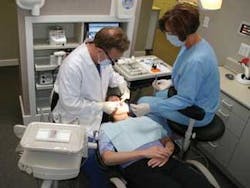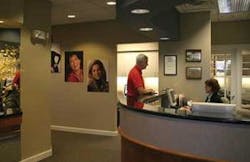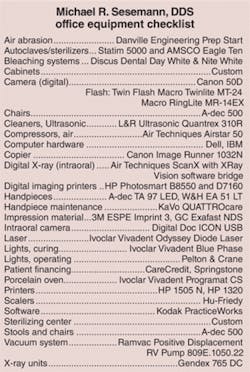The right people make all the difference
Story by Dr. Michael Sesemann
Photography by Ervin Photography and Unthank Design Group
For more on this topic, go to www.dentaleconomics.com and search using the following key words: Dr. Michael Sesemann, Unthank Design Group, AACD, the right people.
Anyone who has read Jim Collins' book, “Good to Great,” comes away with excellent tools for making life, work, and business more predictably successful. One of the three main areas of discipline referred to throughout the text is “disciplined people.” The reader is informed that the old adage, “People are your most important asset is wrong …. People are not your most important asset — the right people are.”1
Therefore, you always look for the right people to staff a business. When you find them, treat them fairly. Try to keep them for a long time, if not for the life of the business. I have tried to live by this principle. My seven staff members at the Nebraska Institute of Cosmetic Dentistry have a combined 133 years of experience — all at my office. Without hesitation, I would credit my staff as the secret to our success.
At the turn of the century, it was time for our practice to make a move. As I approached the 20–year mark in private practice, we knew it was time to upgrade our environment to more closely reflect the practice. I had acted as general contractor for the construction of my two previous offices. I relied upon an informal network of subcontractors that were comprised of friends, patients, and our local dental supply company. This time, though, would be different. Our next move required an expert in contemporary dental office design. We again needed to find the right people.
Step 1: Finding the right people
Before settling on a particular site, I attended numerous office design courses. From these experiences, Michael Unthank, DDS, of Unthank Design Group caught my interest. The rapport between Dr. Unthank and myself was good. I felt that he was the person I could trust to successfully complete the process of finding a new office site and completing plans for bids and construction. At the time, I didn't realize what an important role that trust would play in the process.
Step 2: Finding a site
Having found the right person to help us, I set out to find a new office site. I thought that I had a better sense of my practice needs than anyone. What I would learn was how valuable the objective advice of someone with formal office design expertise would be.
The process began with Dr. Unthank conducting thorough interviews with my staff members and me to find out our history and course of evolution. After the interview process, I presented some photos of what I considered potential new office sites to Dr. Unthank for his opinion. He kindly informed me that my proposed site selections would not work. None, he thought, were suitable for what we were about to become.
From the interviews, Dr. Unthank gathered much information. For instance, he knew that my staff and I had become Accredited with the American Academy of Cosmetic Dentistry (AACD) a year earlier. In a year, I was going to be Chair of Accreditation. I learned that his experience and system of helping many other dental practices enabled him to foretell my future better than me!
These types of discussions tested our relationship early; however, I graciously admit that the most significant service Unthank Design Group did was help me clarify my vision. The exercise of writing down and communicating my wants and needs to Dr. Unthank helped in every facet of creating the new office, from location selection to completion.
But it was not an easy part of the process. It meant there would be times when the architectural firm would challenge our beliefs and question our choices. If my staff and I could properly defend a choice, it was most likely essential to our practice. If we couldn't, we needed to rethink the decision. This is where the element of trust played such an important role.
The value of this part of the process is validated every time I drive by the sites that I initially proposed. Even though some of those sites eventually became dental offices, it is very clear to me that Dr. Unthank was right. None of the sites would have been the right fit for our future.
Step 3: Planning the details
Having a veteran staff definitely paid off during the planning stage. The entire staff was involved in the detailed planning. That was part of the plan. No one knew their areas better than they did, and because they had chosen to remain with the practice as a career, they deserved to have a hand in the design of their work areas. This included personal spaces.
In terms of technology, I am not a person who initially embraces every new offering when it first is released. The technology has to prove itself to me and illustrate that it fits our current business concepts. What was important to me was that the office plan be designed to accept new technology when we chose to acquire it in the future.
With the help of Dr. Unthank and his design group, current and future technology needs were designed into the plan. Wiring “pull throughs” were incorporated into the design, as was construction for the eventual computerization of the office, although we had run the practice from a centralized business computer system since the late 1980s.
I was not yet ready to choose the hardware and software needs for my future office in the year 2001. In the coming years, I thought technology was going to expand greatly and I didn't want to invest during a time before critical evolutions.
Therefore, we chose not to incorporate digital radiography at the opening of the new office. Instead, the decision was made at a later date when the technology was more advanced and aligned with our methods. Also, by not implementating extensive technology at the same time as the practice move, my staff concentrated on patients and eased them into the flow of our new space.
We added digital radiography and computerization a few years later when we could concentrate solely on its implementation. Hence, operatory computerization occurred years after the construction. But, because of the pull–throughs that were initially installed, the later additions were added easily and blended with the initial construction as if they had been installed on Day 1.
In terms of the interior design, Dr. Unthank and his people made selection of furnishings and finish treatments easy. The in–depth initial interviews and follow–ups gave them the information needed to meet our objectives of presenting a clean, modern appearance with an emphasis on functionality.
Step 4: Bids and construction
Once the design and renderings were finished, I was amazed at how easy construction was with a complete set of plans. From the bidding process to the conclusion of construction, every detail was accounted for. I realized what a relief it was not to have the headaches of being the general contractor. I enjoyed not having to answer questions each day of construction.
By the time we moved into our new digs, we knew what was awaiting. We had already imagined it in our minds. Having the right people in place made all the difference.
1. Collins J. Good to Great — Why Some Companies Make the Leap … and Others Don't. 1st ed. New York, NY. HarperCollins Publishers, Inc. 2001.





